Information Systems in Organizations: Analysis of Marks and Spencer
VerifiedAdded on 2020/07/23
|17
|5277
|417
Report
AI Summary
This report examines the application of information systems within organizations, using Marks and Spencer as a case study. It begins by evaluating the information needs of various functional areas within the company, including finance, human resources, sales, training, and administration. The report then describes different types of information systems, such as transaction processing systems, management information systems, decision support systems, executive support systems, and knowledge management systems, and how they are used to solve business problems. Furthermore, it investigates current trends in information systems applications, including the integration of executive support systems with decision support systems and the importance of both internal and external data sources for management information systems. The report also includes a discussion on how to generate accurate and useful information using information systems and evaluates alternative methods for solving business problems, providing a comprehensive overview of the role and impact of information systems in a real-world business context.
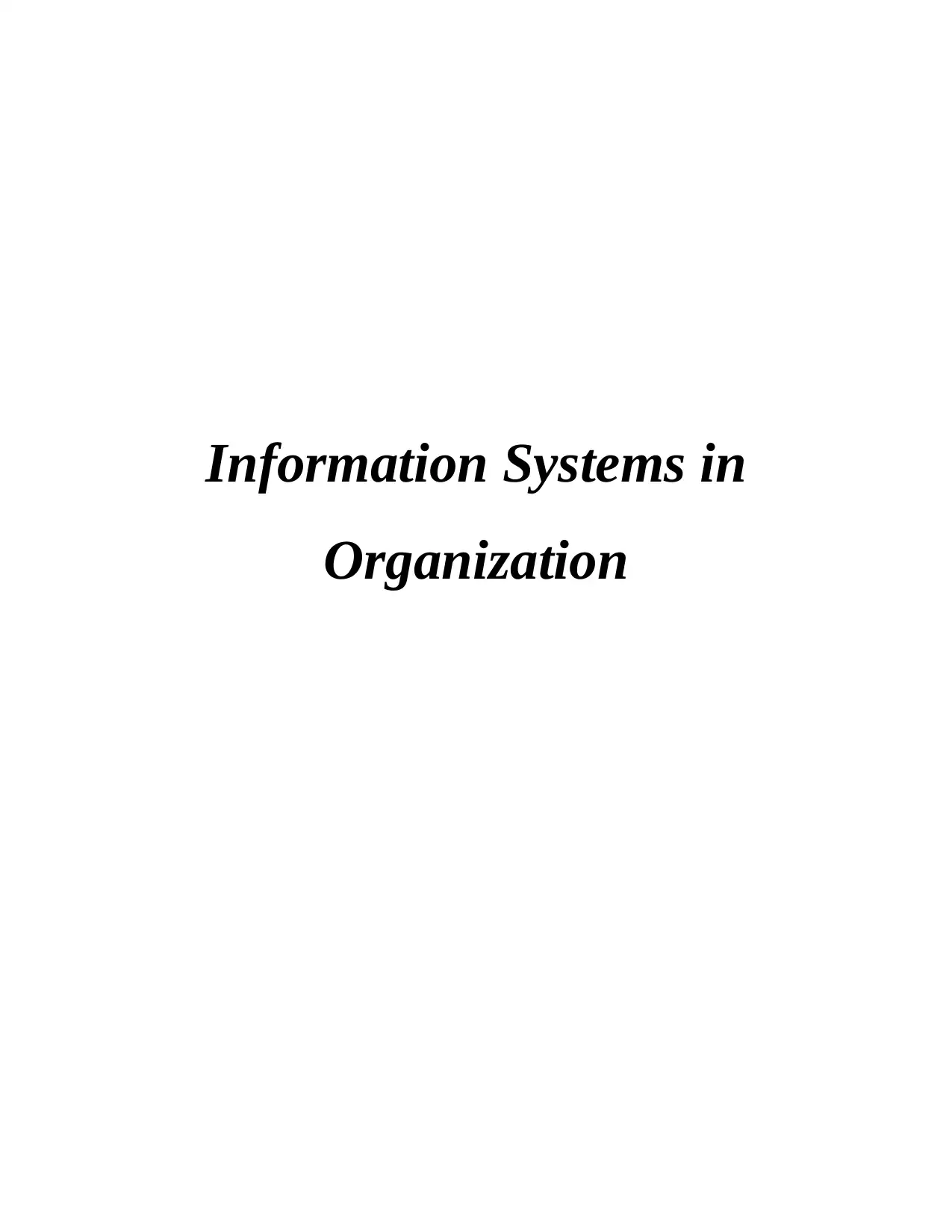
Information Systems in
Organization
Organization
Paraphrase This Document
Need a fresh take? Get an instant paraphrase of this document with our AI Paraphraser
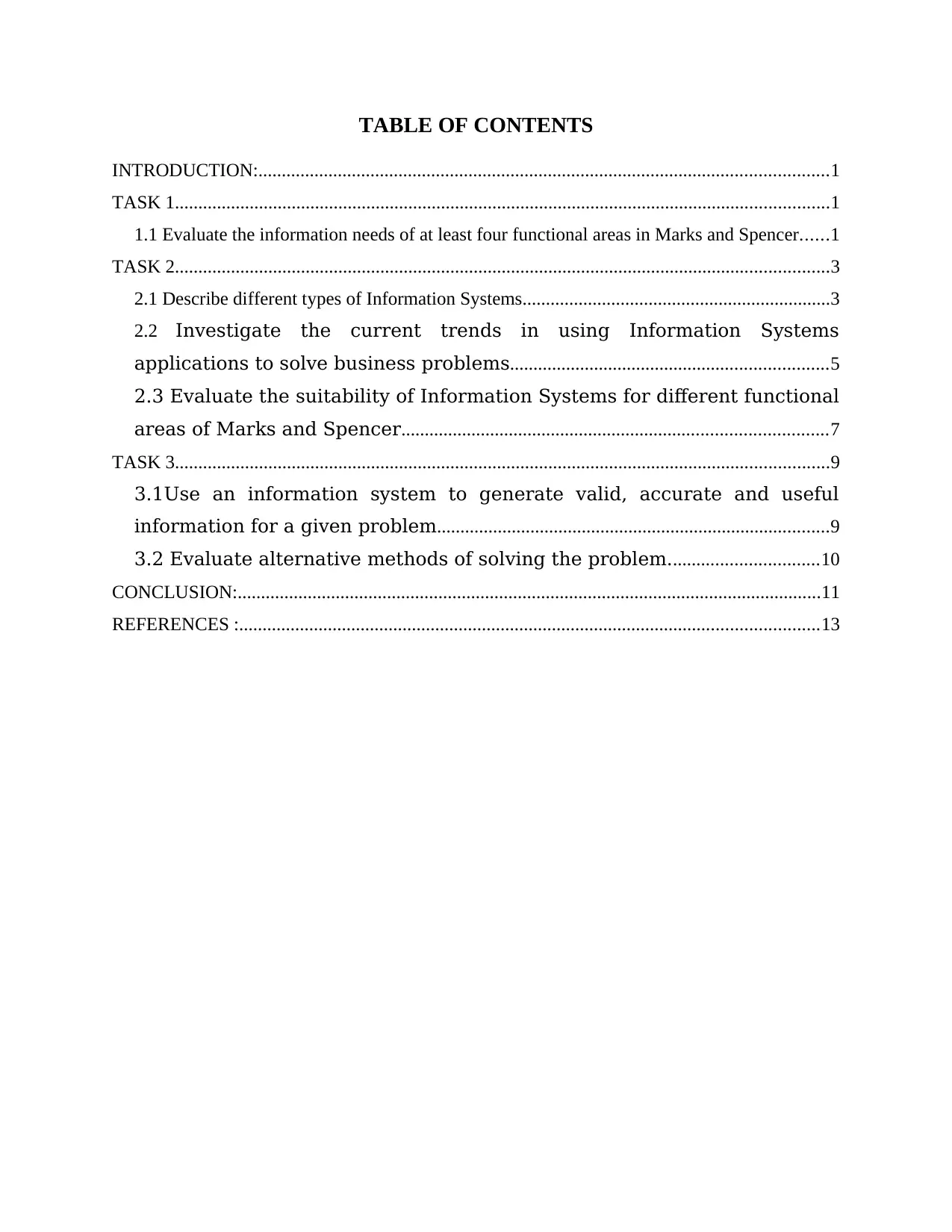
TABLE OF CONTENTS
INTRODUCTION:..........................................................................................................................1
TASK 1............................................................................................................................................1
1.1 Evaluate the information needs of at least four functional areas in Marks and Spencer......1
TASK 2............................................................................................................................................3
2.1 Describe different types of Information Systems..................................................................3
2.2 Investigate the current trends in using Information Systems
applications to solve business problems....................................................................5
2.3 Evaluate the suitability of Information Systems for different functional
areas of Marks and Spencer...........................................................................................7
TASK 3............................................................................................................................................9
3.1Use an information system to generate valid, accurate and useful
information for a given problem....................................................................................9
3.2 Evaluate alternative methods of solving the problem................................10
CONCLUSION:.............................................................................................................................11
REFERENCES :............................................................................................................................13
INTRODUCTION:..........................................................................................................................1
TASK 1............................................................................................................................................1
1.1 Evaluate the information needs of at least four functional areas in Marks and Spencer......1
TASK 2............................................................................................................................................3
2.1 Describe different types of Information Systems..................................................................3
2.2 Investigate the current trends in using Information Systems
applications to solve business problems....................................................................5
2.3 Evaluate the suitability of Information Systems for different functional
areas of Marks and Spencer...........................................................................................7
TASK 3............................................................................................................................................9
3.1Use an information system to generate valid, accurate and useful
information for a given problem....................................................................................9
3.2 Evaluate alternative methods of solving the problem................................10
CONCLUSION:.............................................................................................................................11
REFERENCES :............................................................................................................................13
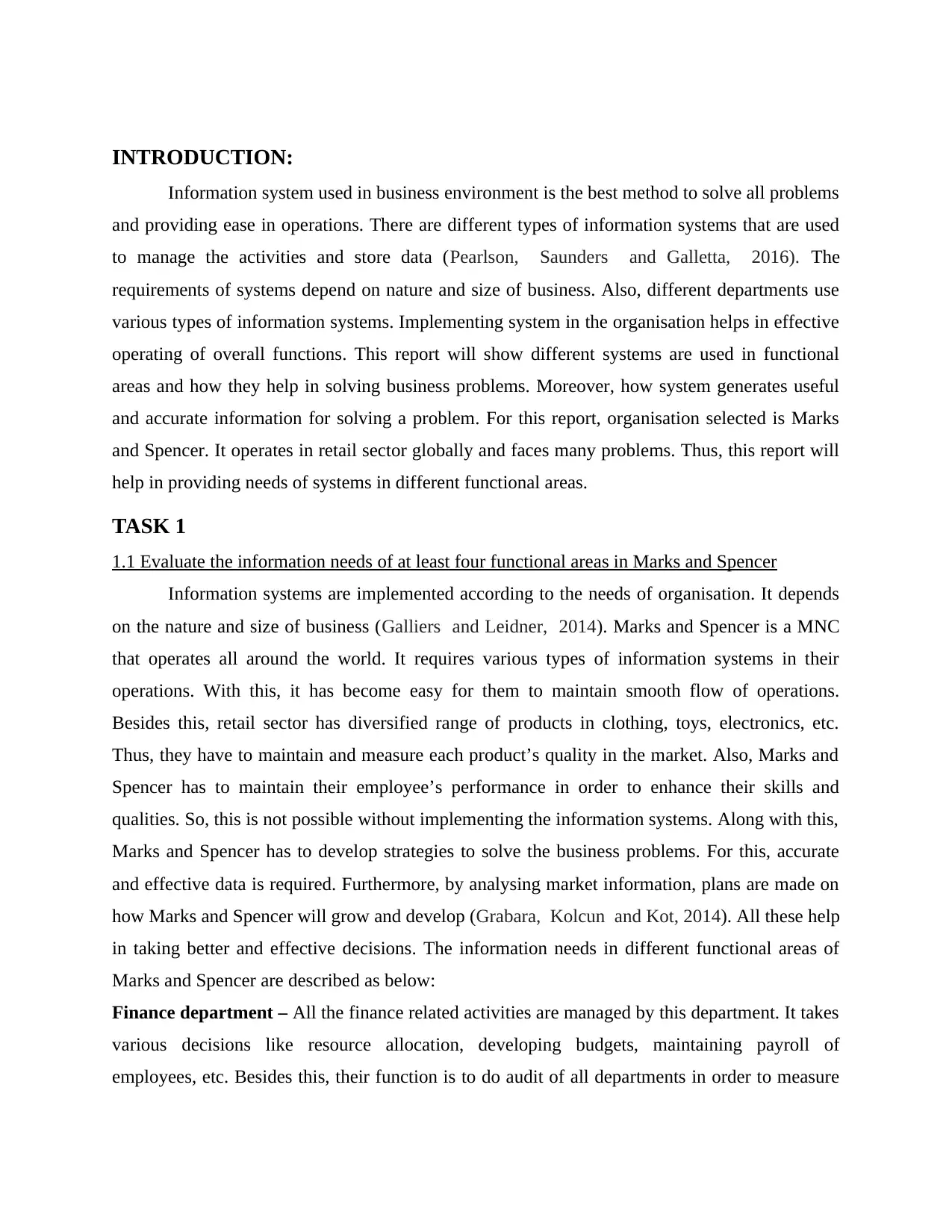
INTRODUCTION:
Information system used in business environment is the best method to solve all problems
and providing ease in operations. There are different types of information systems that are used
to manage the activities and store data (Pearlson, Saunders and Galletta, 2016). The
requirements of systems depend on nature and size of business. Also, different departments use
various types of information systems. Implementing system in the organisation helps in effective
operating of overall functions. This report will show different systems are used in functional
areas and how they help in solving business problems. Moreover, how system generates useful
and accurate information for solving a problem. For this report, organisation selected is Marks
and Spencer. It operates in retail sector globally and faces many problems. Thus, this report will
help in providing needs of systems in different functional areas.
TASK 1
1.1 Evaluate the information needs of at least four functional areas in Marks and Spencer
Information systems are implemented according to the needs of organisation. It depends
on the nature and size of business (Galliers and Leidner, 2014). Marks and Spencer is a MNC
that operates all around the world. It requires various types of information systems in their
operations. With this, it has become easy for them to maintain smooth flow of operations.
Besides this, retail sector has diversified range of products in clothing, toys, electronics, etc.
Thus, they have to maintain and measure each product’s quality in the market. Also, Marks and
Spencer has to maintain their employee’s performance in order to enhance their skills and
qualities. So, this is not possible without implementing the information systems. Along with this,
Marks and Spencer has to develop strategies to solve the business problems. For this, accurate
and effective data is required. Furthermore, by analysing market information, plans are made on
how Marks and Spencer will grow and develop (Grabara, Kolcun and Kot, 2014). All these help
in taking better and effective decisions. The information needs in different functional areas of
Marks and Spencer are described as below:
Finance department – All the finance related activities are managed by this department. It takes
various decisions like resource allocation, developing budgets, maintaining payroll of
employees, etc. Besides this, their function is to do audit of all departments in order to measure
Information system used in business environment is the best method to solve all problems
and providing ease in operations. There are different types of information systems that are used
to manage the activities and store data (Pearlson, Saunders and Galletta, 2016). The
requirements of systems depend on nature and size of business. Also, different departments use
various types of information systems. Implementing system in the organisation helps in effective
operating of overall functions. This report will show different systems are used in functional
areas and how they help in solving business problems. Moreover, how system generates useful
and accurate information for solving a problem. For this report, organisation selected is Marks
and Spencer. It operates in retail sector globally and faces many problems. Thus, this report will
help in providing needs of systems in different functional areas.
TASK 1
1.1 Evaluate the information needs of at least four functional areas in Marks and Spencer
Information systems are implemented according to the needs of organisation. It depends
on the nature and size of business (Galliers and Leidner, 2014). Marks and Spencer is a MNC
that operates all around the world. It requires various types of information systems in their
operations. With this, it has become easy for them to maintain smooth flow of operations.
Besides this, retail sector has diversified range of products in clothing, toys, electronics, etc.
Thus, they have to maintain and measure each product’s quality in the market. Also, Marks and
Spencer has to maintain their employee’s performance in order to enhance their skills and
qualities. So, this is not possible without implementing the information systems. Along with this,
Marks and Spencer has to develop strategies to solve the business problems. For this, accurate
and effective data is required. Furthermore, by analysing market information, plans are made on
how Marks and Spencer will grow and develop (Grabara, Kolcun and Kot, 2014). All these help
in taking better and effective decisions. The information needs in different functional areas of
Marks and Spencer are described as below:
Finance department – All the finance related activities are managed by this department. It takes
various decisions like resource allocation, developing budgets, maintaining payroll of
employees, etc. Besides this, their function is to do audit of all departments in order to measure
⊘ This is a preview!⊘
Do you want full access?
Subscribe today to unlock all pages.

Trusted by 1+ million students worldwide
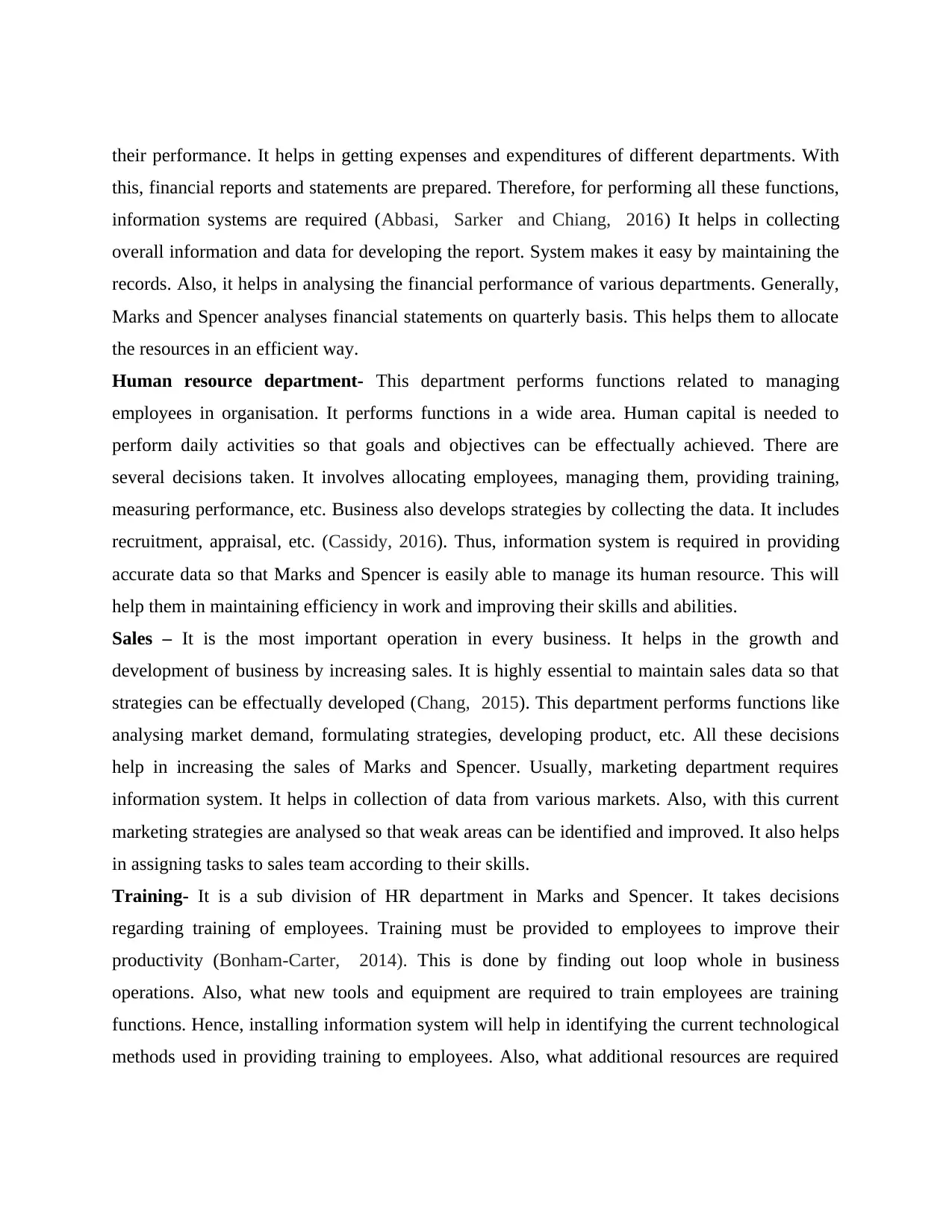
their performance. It helps in getting expenses and expenditures of different departments. With
this, financial reports and statements are prepared. Therefore, for performing all these functions,
information systems are required (Abbasi, Sarker and Chiang, 2016) It helps in collecting
overall information and data for developing the report. System makes it easy by maintaining the
records. Also, it helps in analysing the financial performance of various departments. Generally,
Marks and Spencer analyses financial statements on quarterly basis. This helps them to allocate
the resources in an efficient way.
Human resource department- This department performs functions related to managing
employees in organisation. It performs functions in a wide area. Human capital is needed to
perform daily activities so that goals and objectives can be effectually achieved. There are
several decisions taken. It involves allocating employees, managing them, providing training,
measuring performance, etc. Business also develops strategies by collecting the data. It includes
recruitment, appraisal, etc. (Cassidy, 2016). Thus, information system is required in providing
accurate data so that Marks and Spencer is easily able to manage its human resource. This will
help them in maintaining efficiency in work and improving their skills and abilities.
Sales – It is the most important operation in every business. It helps in the growth and
development of business by increasing sales. It is highly essential to maintain sales data so that
strategies can be effectually developed (Chang, 2015). This department performs functions like
analysing market demand, formulating strategies, developing product, etc. All these decisions
help in increasing the sales of Marks and Spencer. Usually, marketing department requires
information system. It helps in collection of data from various markets. Also, with this current
marketing strategies are analysed so that weak areas can be identified and improved. It also helps
in assigning tasks to sales team according to their skills.
Training- It is a sub division of HR department in Marks and Spencer. It takes decisions
regarding training of employees. Training must be provided to employees to improve their
productivity (Bonham-Carter, 2014). This is done by finding out loop whole in business
operations. Also, what new tools and equipment are required to train employees are training
functions. Hence, installing information system will help in identifying the current technological
methods used in providing training to employees. Also, what additional resources are required
this, financial reports and statements are prepared. Therefore, for performing all these functions,
information systems are required (Abbasi, Sarker and Chiang, 2016) It helps in collecting
overall information and data for developing the report. System makes it easy by maintaining the
records. Also, it helps in analysing the financial performance of various departments. Generally,
Marks and Spencer analyses financial statements on quarterly basis. This helps them to allocate
the resources in an efficient way.
Human resource department- This department performs functions related to managing
employees in organisation. It performs functions in a wide area. Human capital is needed to
perform daily activities so that goals and objectives can be effectually achieved. There are
several decisions taken. It involves allocating employees, managing them, providing training,
measuring performance, etc. Business also develops strategies by collecting the data. It includes
recruitment, appraisal, etc. (Cassidy, 2016). Thus, information system is required in providing
accurate data so that Marks and Spencer is easily able to manage its human resource. This will
help them in maintaining efficiency in work and improving their skills and abilities.
Sales – It is the most important operation in every business. It helps in the growth and
development of business by increasing sales. It is highly essential to maintain sales data so that
strategies can be effectually developed (Chang, 2015). This department performs functions like
analysing market demand, formulating strategies, developing product, etc. All these decisions
help in increasing the sales of Marks and Spencer. Usually, marketing department requires
information system. It helps in collection of data from various markets. Also, with this current
marketing strategies are analysed so that weak areas can be identified and improved. It also helps
in assigning tasks to sales team according to their skills.
Training- It is a sub division of HR department in Marks and Spencer. It takes decisions
regarding training of employees. Training must be provided to employees to improve their
productivity (Bonham-Carter, 2014). This is done by finding out loop whole in business
operations. Also, what new tools and equipment are required to train employees are training
functions. Hence, installing information system will help in identifying the current technological
methods used in providing training to employees. Also, what additional resources are required
Paraphrase This Document
Need a fresh take? Get an instant paraphrase of this document with our AI Paraphraser
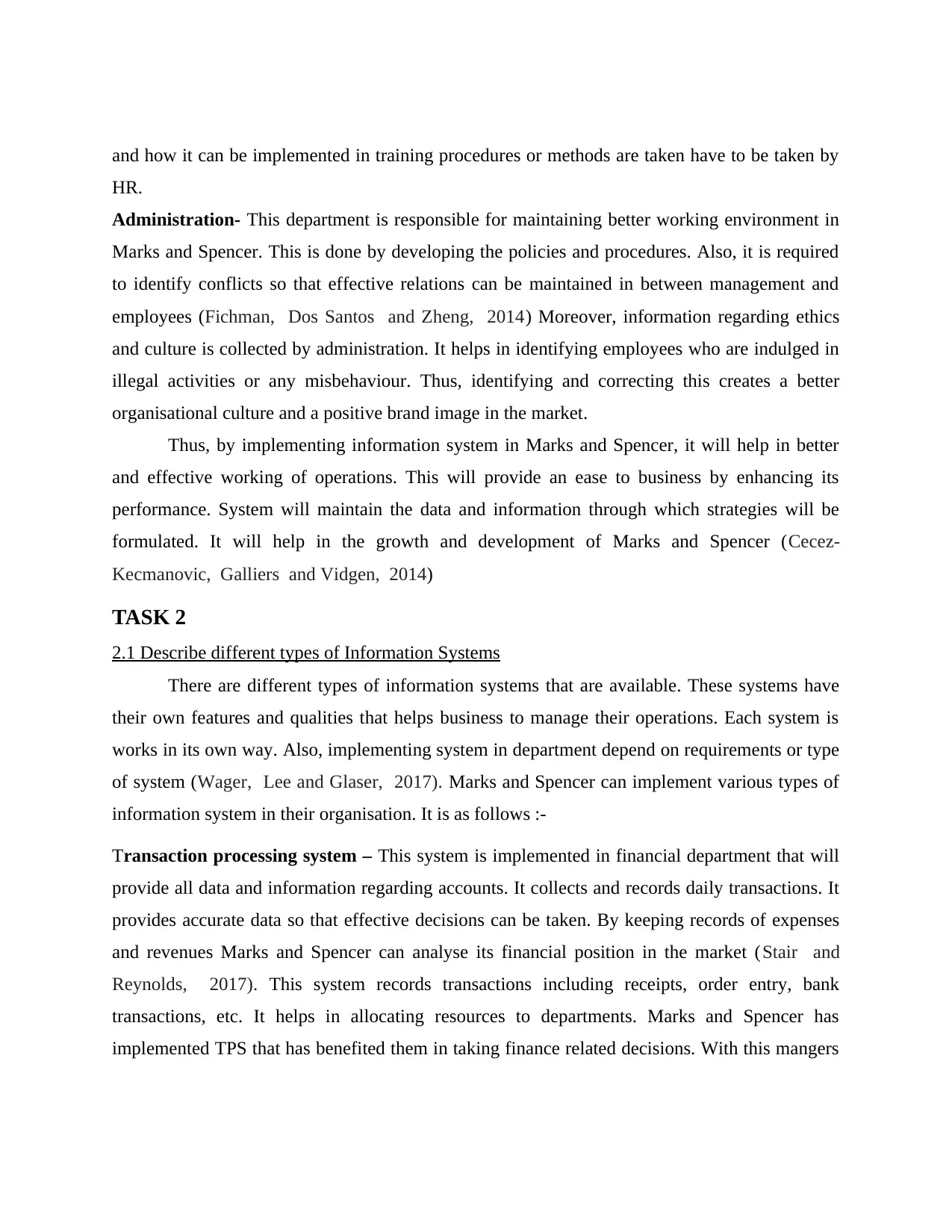
and how it can be implemented in training procedures or methods are taken have to be taken by
HR.
Administration- This department is responsible for maintaining better working environment in
Marks and Spencer. This is done by developing the policies and procedures. Also, it is required
to identify conflicts so that effective relations can be maintained in between management and
employees (Fichman, Dos Santos and Zheng, 2014) Moreover, information regarding ethics
and culture is collected by administration. It helps in identifying employees who are indulged in
illegal activities or any misbehaviour. Thus, identifying and correcting this creates a better
organisational culture and a positive brand image in the market.
Thus, by implementing information system in Marks and Spencer, it will help in better
and effective working of operations. This will provide an ease to business by enhancing its
performance. System will maintain the data and information through which strategies will be
formulated. It will help in the growth and development of Marks and Spencer (Cecez-
Kecmanovic, Galliers and Vidgen, 2014)
TASK 2
2.1 Describe different types of Information Systems
There are different types of information systems that are available. These systems have
their own features and qualities that helps business to manage their operations. Each system is
works in its own way. Also, implementing system in department depend on requirements or type
of system (Wager, Lee and Glaser, 2017). Marks and Spencer can implement various types of
information system in their organisation. It is as follows :-
Transaction processing system – This system is implemented in financial department that will
provide all data and information regarding accounts. It collects and records daily transactions. It
provides accurate data so that effective decisions can be taken. By keeping records of expenses
and revenues Marks and Spencer can analyse its financial position in the market (Stair and
Reynolds, 2017). This system records transactions including receipts, order entry, bank
transactions, etc. It helps in allocating resources to departments. Marks and Spencer has
implemented TPS that has benefited them in taking finance related decisions. With this mangers
HR.
Administration- This department is responsible for maintaining better working environment in
Marks and Spencer. This is done by developing the policies and procedures. Also, it is required
to identify conflicts so that effective relations can be maintained in between management and
employees (Fichman, Dos Santos and Zheng, 2014) Moreover, information regarding ethics
and culture is collected by administration. It helps in identifying employees who are indulged in
illegal activities or any misbehaviour. Thus, identifying and correcting this creates a better
organisational culture and a positive brand image in the market.
Thus, by implementing information system in Marks and Spencer, it will help in better
and effective working of operations. This will provide an ease to business by enhancing its
performance. System will maintain the data and information through which strategies will be
formulated. It will help in the growth and development of Marks and Spencer (Cecez-
Kecmanovic, Galliers and Vidgen, 2014)
TASK 2
2.1 Describe different types of Information Systems
There are different types of information systems that are available. These systems have
their own features and qualities that helps business to manage their operations. Each system is
works in its own way. Also, implementing system in department depend on requirements or type
of system (Wager, Lee and Glaser, 2017). Marks and Spencer can implement various types of
information system in their organisation. It is as follows :-
Transaction processing system – This system is implemented in financial department that will
provide all data and information regarding accounts. It collects and records daily transactions. It
provides accurate data so that effective decisions can be taken. By keeping records of expenses
and revenues Marks and Spencer can analyse its financial position in the market (Stair and
Reynolds, 2017). This system records transactions including receipts, order entry, bank
transactions, etc. It helps in allocating resources to departments. Marks and Spencer has
implemented TPS that has benefited them in taking finance related decisions. With this mangers
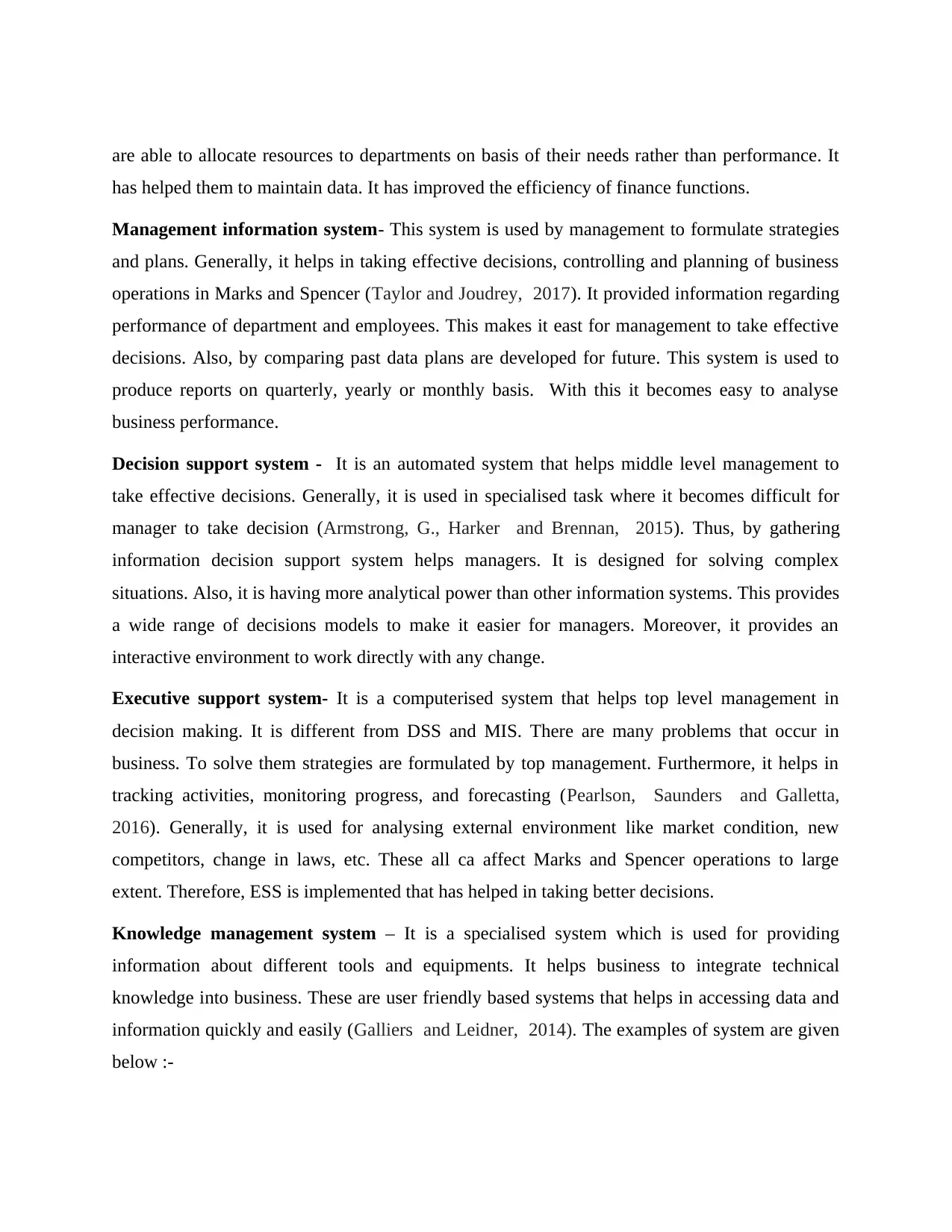
are able to allocate resources to departments on basis of their needs rather than performance. It
has helped them to maintain data. It has improved the efficiency of finance functions.
Management information system- This system is used by management to formulate strategies
and plans. Generally, it helps in taking effective decisions, controlling and planning of business
operations in Marks and Spencer (Taylor and Joudrey, 2017). It provided information regarding
performance of department and employees. This makes it east for management to take effective
decisions. Also, by comparing past data plans are developed for future. This system is used to
produce reports on quarterly, yearly or monthly basis. With this it becomes easy to analyse
business performance.
Decision support system - It is an automated system that helps middle level management to
take effective decisions. Generally, it is used in specialised task where it becomes difficult for
manager to take decision (Armstrong, G., Harker and Brennan, 2015). Thus, by gathering
information decision support system helps managers. It is designed for solving complex
situations. Also, it is having more analytical power than other information systems. This provides
a wide range of decisions models to make it easier for managers. Moreover, it provides an
interactive environment to work directly with any change.
Executive support system- It is a computerised system that helps top level management in
decision making. It is different from DSS and MIS. There are many problems that occur in
business. To solve them strategies are formulated by top management. Furthermore, it helps in
tracking activities, monitoring progress, and forecasting (Pearlson, Saunders and Galletta,
2016). Generally, it is used for analysing external environment like market condition, new
competitors, change in laws, etc. These all ca affect Marks and Spencer operations to large
extent. Therefore, ESS is implemented that has helped in taking better decisions.
Knowledge management system – It is a specialised system which is used for providing
information about different tools and equipments. It helps business to integrate technical
knowledge into business. These are user friendly based systems that helps in accessing data and
information quickly and easily (Galliers and Leidner, 2014). The examples of system are given
below :-
has helped them to maintain data. It has improved the efficiency of finance functions.
Management information system- This system is used by management to formulate strategies
and plans. Generally, it helps in taking effective decisions, controlling and planning of business
operations in Marks and Spencer (Taylor and Joudrey, 2017). It provided information regarding
performance of department and employees. This makes it east for management to take effective
decisions. Also, by comparing past data plans are developed for future. This system is used to
produce reports on quarterly, yearly or monthly basis. With this it becomes easy to analyse
business performance.
Decision support system - It is an automated system that helps middle level management to
take effective decisions. Generally, it is used in specialised task where it becomes difficult for
manager to take decision (Armstrong, G., Harker and Brennan, 2015). Thus, by gathering
information decision support system helps managers. It is designed for solving complex
situations. Also, it is having more analytical power than other information systems. This provides
a wide range of decisions models to make it easier for managers. Moreover, it provides an
interactive environment to work directly with any change.
Executive support system- It is a computerised system that helps top level management in
decision making. It is different from DSS and MIS. There are many problems that occur in
business. To solve them strategies are formulated by top management. Furthermore, it helps in
tracking activities, monitoring progress, and forecasting (Pearlson, Saunders and Galletta,
2016). Generally, it is used for analysing external environment like market condition, new
competitors, change in laws, etc. These all ca affect Marks and Spencer operations to large
extent. Therefore, ESS is implemented that has helped in taking better decisions.
Knowledge management system – It is a specialised system which is used for providing
information about different tools and equipments. It helps business to integrate technical
knowledge into business. These are user friendly based systems that helps in accessing data and
information quickly and easily (Galliers and Leidner, 2014). The examples of system are given
below :-
⊘ This is a preview!⊘
Do you want full access?
Subscribe today to unlock all pages.

Trusted by 1+ million students worldwide
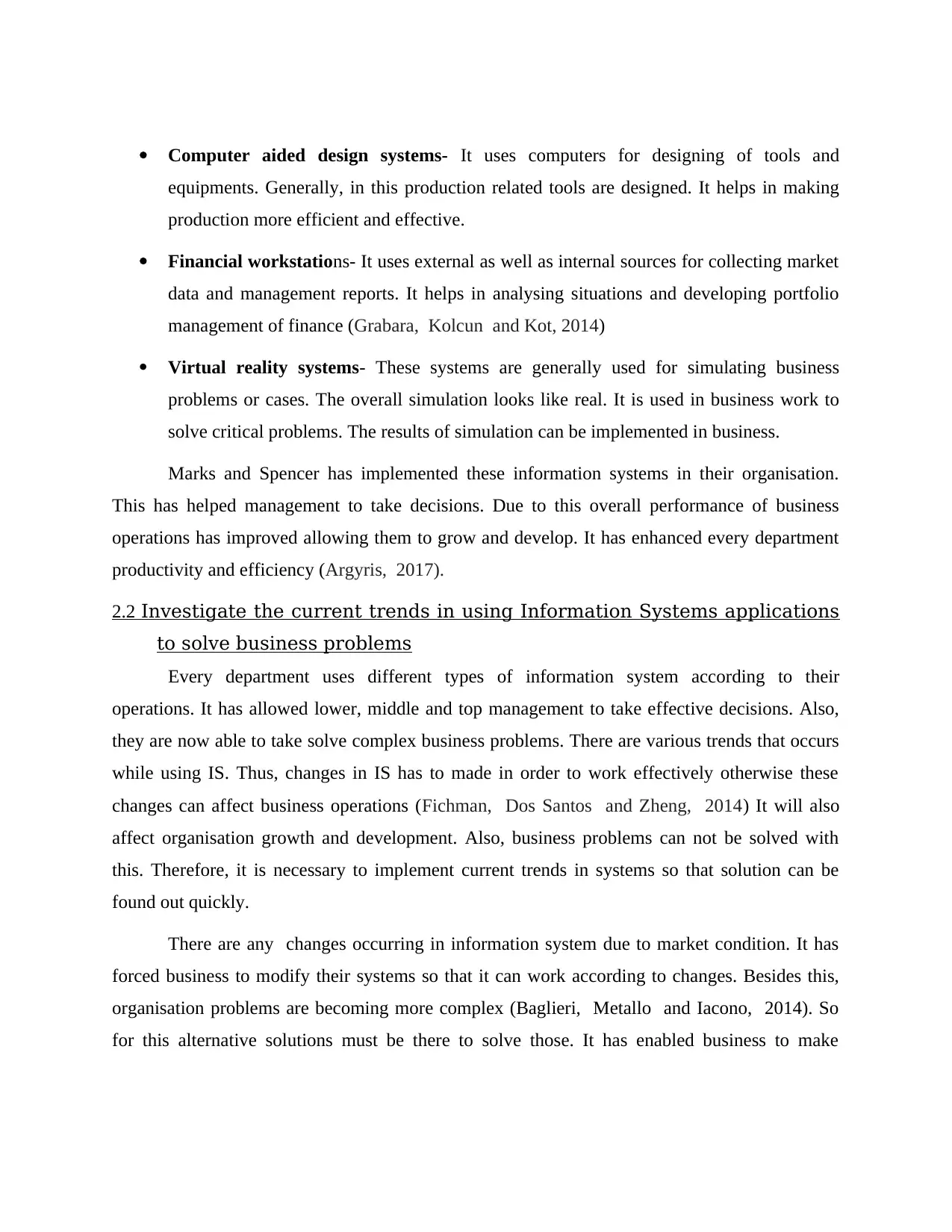
Computer aided design systems- It uses computers for designing of tools and
equipments. Generally, in this production related tools are designed. It helps in making
production more efficient and effective.
Financial workstations- It uses external as well as internal sources for collecting market
data and management reports. It helps in analysing situations and developing portfolio
management of finance (Grabara, Kolcun and Kot, 2014)
Virtual reality systems- These systems are generally used for simulating business
problems or cases. The overall simulation looks like real. It is used in business work to
solve critical problems. The results of simulation can be implemented in business.
Marks and Spencer has implemented these information systems in their organisation.
This has helped management to take decisions. Due to this overall performance of business
operations has improved allowing them to grow and develop. It has enhanced every department
productivity and efficiency (Argyris, 2017).
2.2 Investigate the current trends in using Information Systems applications
to solve business problems
Every department uses different types of information system according to their
operations. It has allowed lower, middle and top management to take effective decisions. Also,
they are now able to take solve complex business problems. There are various trends that occurs
while using IS. Thus, changes in IS has to made in order to work effectively otherwise these
changes can affect business operations (Fichman, Dos Santos and Zheng, 2014) It will also
affect organisation growth and development. Also, business problems can not be solved with
this. Therefore, it is necessary to implement current trends in systems so that solution can be
found out quickly.
There are any changes occurring in information system due to market condition. It has
forced business to modify their systems so that it can work according to changes. Besides this,
organisation problems are becoming more complex (Baglieri, Metallo and Iacono, 2014). So
for this alternative solutions must be there to solve those. It has enabled business to make
equipments. Generally, in this production related tools are designed. It helps in making
production more efficient and effective.
Financial workstations- It uses external as well as internal sources for collecting market
data and management reports. It helps in analysing situations and developing portfolio
management of finance (Grabara, Kolcun and Kot, 2014)
Virtual reality systems- These systems are generally used for simulating business
problems or cases. The overall simulation looks like real. It is used in business work to
solve critical problems. The results of simulation can be implemented in business.
Marks and Spencer has implemented these information systems in their organisation.
This has helped management to take decisions. Due to this overall performance of business
operations has improved allowing them to grow and develop. It has enhanced every department
productivity and efficiency (Argyris, 2017).
2.2 Investigate the current trends in using Information Systems applications
to solve business problems
Every department uses different types of information system according to their
operations. It has allowed lower, middle and top management to take effective decisions. Also,
they are now able to take solve complex business problems. There are various trends that occurs
while using IS. Thus, changes in IS has to made in order to work effectively otherwise these
changes can affect business operations (Fichman, Dos Santos and Zheng, 2014) It will also
affect organisation growth and development. Also, business problems can not be solved with
this. Therefore, it is necessary to implement current trends in systems so that solution can be
found out quickly.
There are any changes occurring in information system due to market condition. It has
forced business to modify their systems so that it can work according to changes. Besides this,
organisation problems are becoming more complex (Baglieri, Metallo and Iacono, 2014). So
for this alternative solutions must be there to solve those. It has enabled business to make
Paraphrase This Document
Need a fresh take? Get an instant paraphrase of this document with our AI Paraphraser
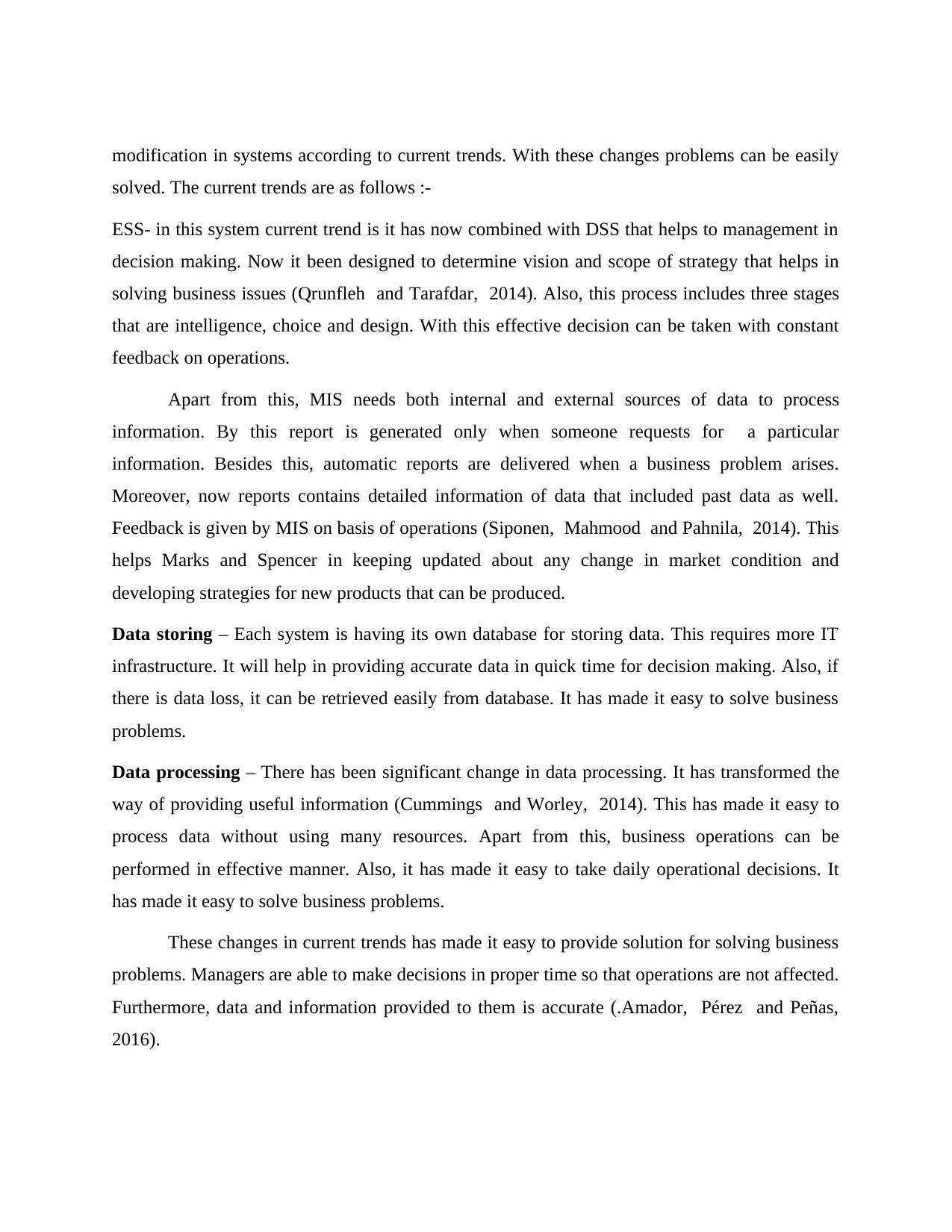
modification in systems according to current trends. With these changes problems can be easily
solved. The current trends are as follows :-
ESS- in this system current trend is it has now combined with DSS that helps to management in
decision making. Now it been designed to determine vision and scope of strategy that helps in
solving business issues (Qrunfleh and Tarafdar, 2014). Also, this process includes three stages
that are intelligence, choice and design. With this effective decision can be taken with constant
feedback on operations.
Apart from this, MIS needs both internal and external sources of data to process
information. By this report is generated only when someone requests for a particular
information. Besides this, automatic reports are delivered when a business problem arises.
Moreover, now reports contains detailed information of data that included past data as well.
Feedback is given by MIS on basis of operations (Siponen, Mahmood and Pahnila, 2014). This
helps Marks and Spencer in keeping updated about any change in market condition and
developing strategies for new products that can be produced.
Data storing – Each system is having its own database for storing data. This requires more IT
infrastructure. It will help in providing accurate data in quick time for decision making. Also, if
there is data loss, it can be retrieved easily from database. It has made it easy to solve business
problems.
Data processing – There has been significant change in data processing. It has transformed the
way of providing useful information (Cummings and Worley, 2014). This has made it easy to
process data without using many resources. Apart from this, business operations can be
performed in effective manner. Also, it has made it easy to take daily operational decisions. It
has made it easy to solve business problems.
These changes in current trends has made it easy to provide solution for solving business
problems. Managers are able to make decisions in proper time so that operations are not affected.
Furthermore, data and information provided to them is accurate (.Amador, Pérez and Peñas,
2016).
solved. The current trends are as follows :-
ESS- in this system current trend is it has now combined with DSS that helps to management in
decision making. Now it been designed to determine vision and scope of strategy that helps in
solving business issues (Qrunfleh and Tarafdar, 2014). Also, this process includes three stages
that are intelligence, choice and design. With this effective decision can be taken with constant
feedback on operations.
Apart from this, MIS needs both internal and external sources of data to process
information. By this report is generated only when someone requests for a particular
information. Besides this, automatic reports are delivered when a business problem arises.
Moreover, now reports contains detailed information of data that included past data as well.
Feedback is given by MIS on basis of operations (Siponen, Mahmood and Pahnila, 2014). This
helps Marks and Spencer in keeping updated about any change in market condition and
developing strategies for new products that can be produced.
Data storing – Each system is having its own database for storing data. This requires more IT
infrastructure. It will help in providing accurate data in quick time for decision making. Also, if
there is data loss, it can be retrieved easily from database. It has made it easy to solve business
problems.
Data processing – There has been significant change in data processing. It has transformed the
way of providing useful information (Cummings and Worley, 2014). This has made it easy to
process data without using many resources. Apart from this, business operations can be
performed in effective manner. Also, it has made it easy to take daily operational decisions. It
has made it easy to solve business problems.
These changes in current trends has made it easy to provide solution for solving business
problems. Managers are able to make decisions in proper time so that operations are not affected.
Furthermore, data and information provided to them is accurate (.Amador, Pérez and Peñas,
2016).
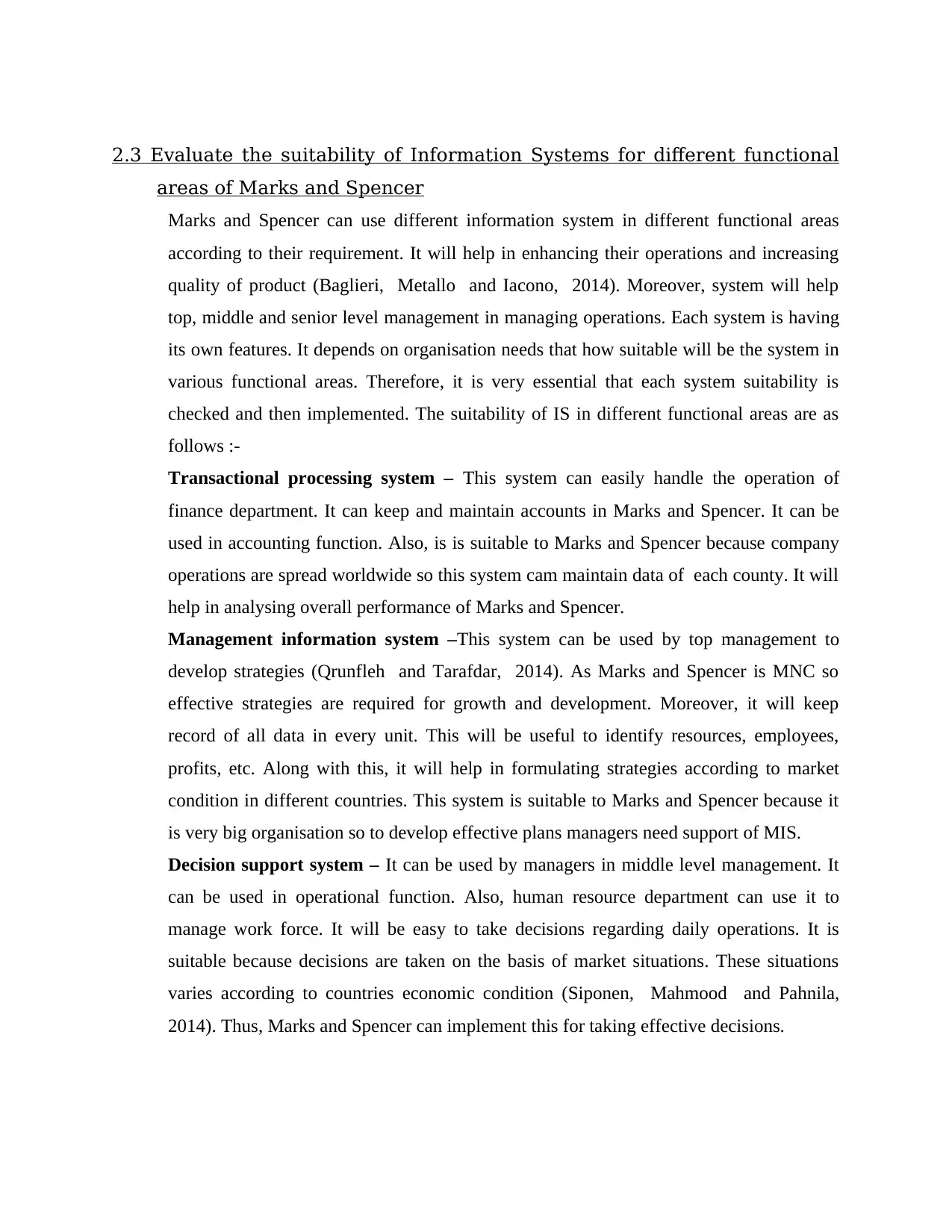
2.3 Evaluate the suitability of Information Systems for different functional
areas of Marks and Spencer
Marks and Spencer can use different information system in different functional areas
according to their requirement. It will help in enhancing their operations and increasing
quality of product (Baglieri, Metallo and Iacono, 2014). Moreover, system will help
top, middle and senior level management in managing operations. Each system is having
its own features. It depends on organisation needs that how suitable will be the system in
various functional areas. Therefore, it is very essential that each system suitability is
checked and then implemented. The suitability of IS in different functional areas are as
follows :-
Transactional processing system – This system can easily handle the operation of
finance department. It can keep and maintain accounts in Marks and Spencer. It can be
used in accounting function. Also, is is suitable to Marks and Spencer because company
operations are spread worldwide so this system cam maintain data of each county. It will
help in analysing overall performance of Marks and Spencer.
Management information system –This system can be used by top management to
develop strategies (Qrunfleh and Tarafdar, 2014). As Marks and Spencer is MNC so
effective strategies are required for growth and development. Moreover, it will keep
record of all data in every unit. This will be useful to identify resources, employees,
profits, etc. Along with this, it will help in formulating strategies according to market
condition in different countries. This system is suitable to Marks and Spencer because it
is very big organisation so to develop effective plans managers need support of MIS.
Decision support system – It can be used by managers in middle level management. It
can be used in operational function. Also, human resource department can use it to
manage work force. It will be easy to take decisions regarding daily operations. It is
suitable because decisions are taken on the basis of market situations. These situations
varies according to countries economic condition (Siponen, Mahmood and Pahnila,
2014). Thus, Marks and Spencer can implement this for taking effective decisions.
areas of Marks and Spencer
Marks and Spencer can use different information system in different functional areas
according to their requirement. It will help in enhancing their operations and increasing
quality of product (Baglieri, Metallo and Iacono, 2014). Moreover, system will help
top, middle and senior level management in managing operations. Each system is having
its own features. It depends on organisation needs that how suitable will be the system in
various functional areas. Therefore, it is very essential that each system suitability is
checked and then implemented. The suitability of IS in different functional areas are as
follows :-
Transactional processing system – This system can easily handle the operation of
finance department. It can keep and maintain accounts in Marks and Spencer. It can be
used in accounting function. Also, is is suitable to Marks and Spencer because company
operations are spread worldwide so this system cam maintain data of each county. It will
help in analysing overall performance of Marks and Spencer.
Management information system –This system can be used by top management to
develop strategies (Qrunfleh and Tarafdar, 2014). As Marks and Spencer is MNC so
effective strategies are required for growth and development. Moreover, it will keep
record of all data in every unit. This will be useful to identify resources, employees,
profits, etc. Along with this, it will help in formulating strategies according to market
condition in different countries. This system is suitable to Marks and Spencer because it
is very big organisation so to develop effective plans managers need support of MIS.
Decision support system – It can be used by managers in middle level management. It
can be used in operational function. Also, human resource department can use it to
manage work force. It will be easy to take decisions regarding daily operations. It is
suitable because decisions are taken on the basis of market situations. These situations
varies according to countries economic condition (Siponen, Mahmood and Pahnila,
2014). Thus, Marks and Spencer can implement this for taking effective decisions.
⊘ This is a preview!⊘
Do you want full access?
Subscribe today to unlock all pages.

Trusted by 1+ million students worldwide
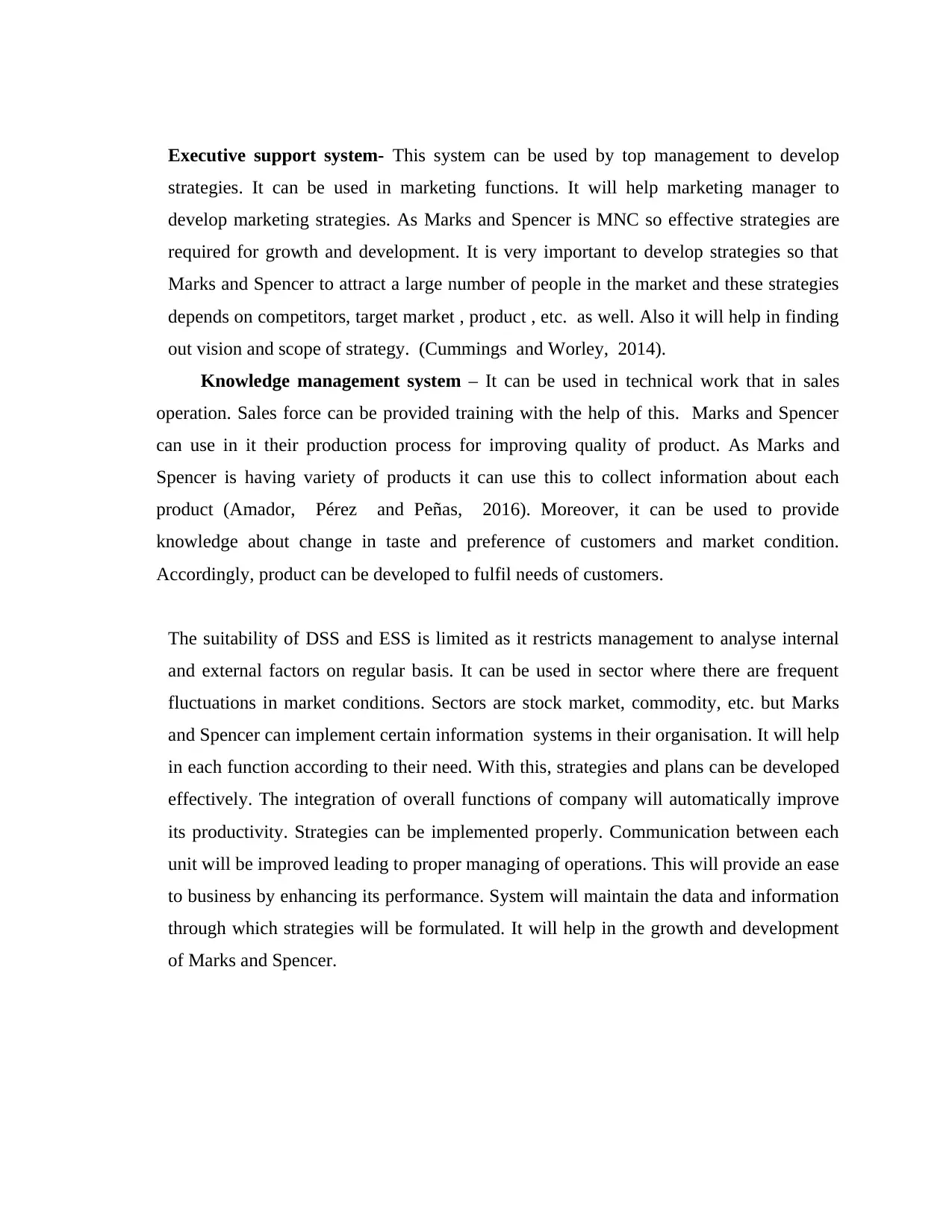
Executive support system- This system can be used by top management to develop
strategies. It can be used in marketing functions. It will help marketing manager to
develop marketing strategies. As Marks and Spencer is MNC so effective strategies are
required for growth and development. It is very important to develop strategies so that
Marks and Spencer to attract a large number of people in the market and these strategies
depends on competitors, target market , product , etc. as well. Also it will help in finding
out vision and scope of strategy. (Cummings and Worley, 2014).
Knowledge management system – It can be used in technical work that in sales
operation. Sales force can be provided training with the help of this. Marks and Spencer
can use in it their production process for improving quality of product. As Marks and
Spencer is having variety of products it can use this to collect information about each
product (Amador, Pérez and Peñas, 2016). Moreover, it can be used to provide
knowledge about change in taste and preference of customers and market condition.
Accordingly, product can be developed to fulfil needs of customers.
The suitability of DSS and ESS is limited as it restricts management to analyse internal
and external factors on regular basis. It can be used in sector where there are frequent
fluctuations in market conditions. Sectors are stock market, commodity, etc. but Marks
and Spencer can implement certain information systems in their organisation. It will help
in each function according to their need. With this, strategies and plans can be developed
effectively. The integration of overall functions of company will automatically improve
its productivity. Strategies can be implemented properly. Communication between each
unit will be improved leading to proper managing of operations. This will provide an ease
to business by enhancing its performance. System will maintain the data and information
through which strategies will be formulated. It will help in the growth and development
of Marks and Spencer.
strategies. It can be used in marketing functions. It will help marketing manager to
develop marketing strategies. As Marks and Spencer is MNC so effective strategies are
required for growth and development. It is very important to develop strategies so that
Marks and Spencer to attract a large number of people in the market and these strategies
depends on competitors, target market , product , etc. as well. Also it will help in finding
out vision and scope of strategy. (Cummings and Worley, 2014).
Knowledge management system – It can be used in technical work that in sales
operation. Sales force can be provided training with the help of this. Marks and Spencer
can use in it their production process for improving quality of product. As Marks and
Spencer is having variety of products it can use this to collect information about each
product (Amador, Pérez and Peñas, 2016). Moreover, it can be used to provide
knowledge about change in taste and preference of customers and market condition.
Accordingly, product can be developed to fulfil needs of customers.
The suitability of DSS and ESS is limited as it restricts management to analyse internal
and external factors on regular basis. It can be used in sector where there are frequent
fluctuations in market conditions. Sectors are stock market, commodity, etc. but Marks
and Spencer can implement certain information systems in their organisation. It will help
in each function according to their need. With this, strategies and plans can be developed
effectively. The integration of overall functions of company will automatically improve
its productivity. Strategies can be implemented properly. Communication between each
unit will be improved leading to proper managing of operations. This will provide an ease
to business by enhancing its performance. System will maintain the data and information
through which strategies will be formulated. It will help in the growth and development
of Marks and Spencer.
Paraphrase This Document
Need a fresh take? Get an instant paraphrase of this document with our AI Paraphraser
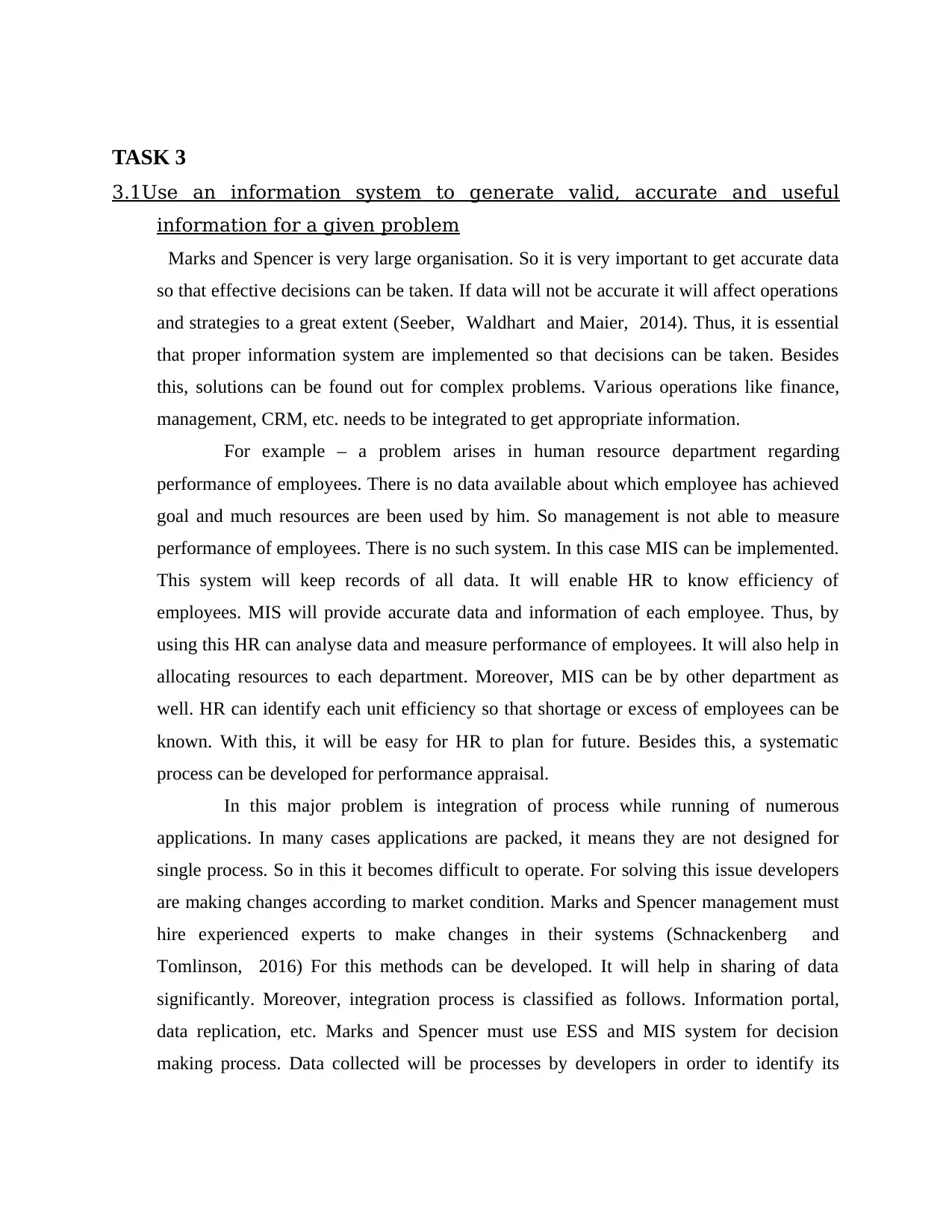
TASK 3
3.1Use an information system to generate valid, accurate and useful
information for a given problem
Marks and Spencer is very large organisation. So it is very important to get accurate data
so that effective decisions can be taken. If data will not be accurate it will affect operations
and strategies to a great extent (Seeber, Waldhart and Maier, 2014). Thus, it is essential
that proper information system are implemented so that decisions can be taken. Besides
this, solutions can be found out for complex problems. Various operations like finance,
management, CRM, etc. needs to be integrated to get appropriate information.
For example – a problem arises in human resource department regarding
performance of employees. There is no data available about which employee has achieved
goal and much resources are been used by him. So management is not able to measure
performance of employees. There is no such system. In this case MIS can be implemented.
This system will keep records of all data. It will enable HR to know efficiency of
employees. MIS will provide accurate data and information of each employee. Thus, by
using this HR can analyse data and measure performance of employees. It will also help in
allocating resources to each department. Moreover, MIS can be by other department as
well. HR can identify each unit efficiency so that shortage or excess of employees can be
known. With this, it will be easy for HR to plan for future. Besides this, a systematic
process can be developed for performance appraisal.
In this major problem is integration of process while running of numerous
applications. In many cases applications are packed, it means they are not designed for
single process. So in this it becomes difficult to operate. For solving this issue developers
are making changes according to market condition. Marks and Spencer management must
hire experienced experts to make changes in their systems (Schnackenberg and
Tomlinson, 2016) For this methods can be developed. It will help in sharing of data
significantly. Moreover, integration process is classified as follows. Information portal,
data replication, etc. Marks and Spencer must use ESS and MIS system for decision
making process. Data collected will be processes by developers in order to identify its
3.1Use an information system to generate valid, accurate and useful
information for a given problem
Marks and Spencer is very large organisation. So it is very important to get accurate data
so that effective decisions can be taken. If data will not be accurate it will affect operations
and strategies to a great extent (Seeber, Waldhart and Maier, 2014). Thus, it is essential
that proper information system are implemented so that decisions can be taken. Besides
this, solutions can be found out for complex problems. Various operations like finance,
management, CRM, etc. needs to be integrated to get appropriate information.
For example – a problem arises in human resource department regarding
performance of employees. There is no data available about which employee has achieved
goal and much resources are been used by him. So management is not able to measure
performance of employees. There is no such system. In this case MIS can be implemented.
This system will keep records of all data. It will enable HR to know efficiency of
employees. MIS will provide accurate data and information of each employee. Thus, by
using this HR can analyse data and measure performance of employees. It will also help in
allocating resources to each department. Moreover, MIS can be by other department as
well. HR can identify each unit efficiency so that shortage or excess of employees can be
known. With this, it will be easy for HR to plan for future. Besides this, a systematic
process can be developed for performance appraisal.
In this major problem is integration of process while running of numerous
applications. In many cases applications are packed, it means they are not designed for
single process. So in this it becomes difficult to operate. For solving this issue developers
are making changes according to market condition. Marks and Spencer management must
hire experienced experts to make changes in their systems (Schnackenberg and
Tomlinson, 2016) For this methods can be developed. It will help in sharing of data
significantly. Moreover, integration process is classified as follows. Information portal,
data replication, etc. Marks and Spencer must use ESS and MIS system for decision
making process. Data collected will be processes by developers in order to identify its
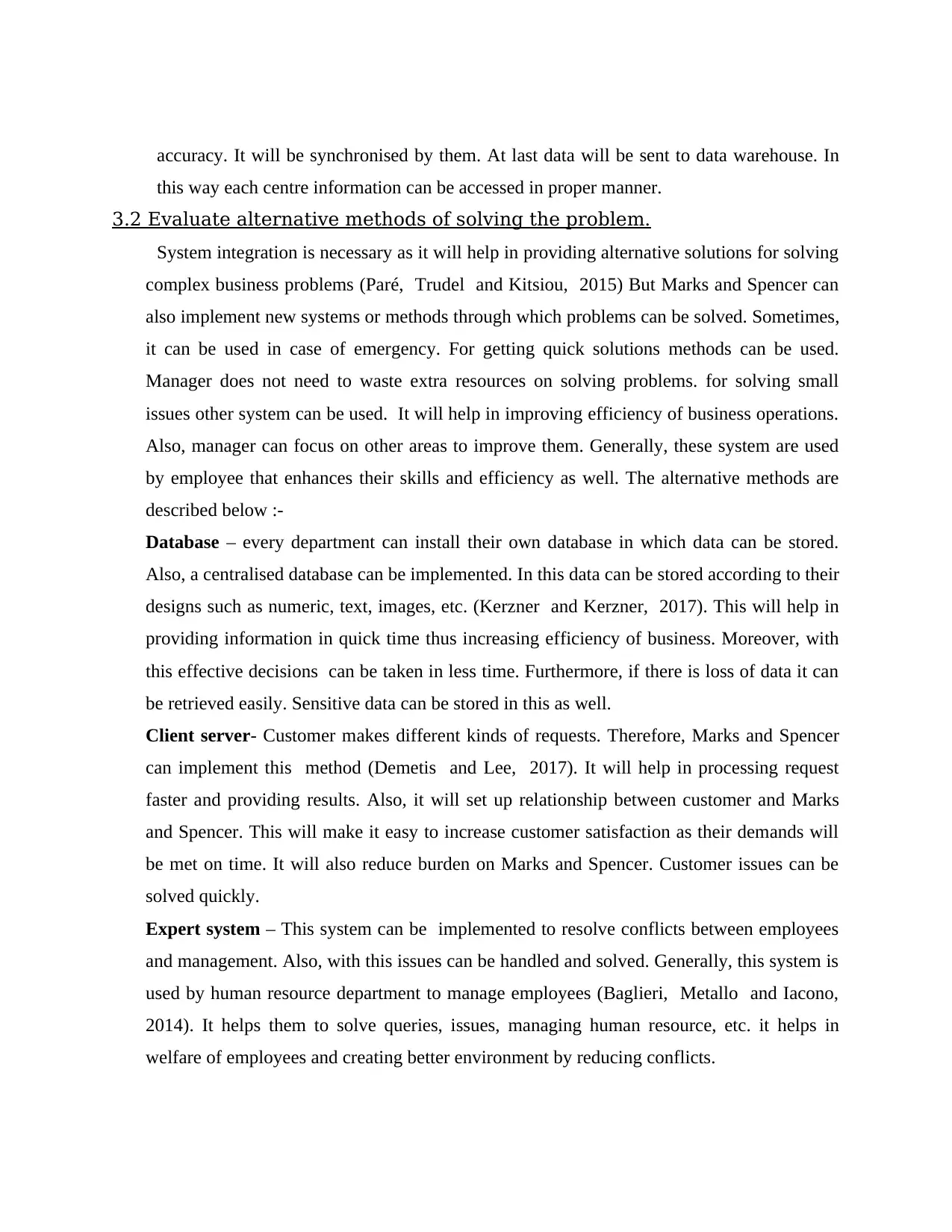
accuracy. It will be synchronised by them. At last data will be sent to data warehouse. In
this way each centre information can be accessed in proper manner.
3.2 Evaluate alternative methods of solving the problem.
System integration is necessary as it will help in providing alternative solutions for solving
complex business problems (Paré, Trudel and Kitsiou, 2015) But Marks and Spencer can
also implement new systems or methods through which problems can be solved. Sometimes,
it can be used in case of emergency. For getting quick solutions methods can be used.
Manager does not need to waste extra resources on solving problems. for solving small
issues other system can be used. It will help in improving efficiency of business operations.
Also, manager can focus on other areas to improve them. Generally, these system are used
by employee that enhances their skills and efficiency as well. The alternative methods are
described below :-
Database – every department can install their own database in which data can be stored.
Also, a centralised database can be implemented. In this data can be stored according to their
designs such as numeric, text, images, etc. (Kerzner and Kerzner, 2017). This will help in
providing information in quick time thus increasing efficiency of business. Moreover, with
this effective decisions can be taken in less time. Furthermore, if there is loss of data it can
be retrieved easily. Sensitive data can be stored in this as well.
Client server- Customer makes different kinds of requests. Therefore, Marks and Spencer
can implement this method (Demetis and Lee, 2017). It will help in processing request
faster and providing results. Also, it will set up relationship between customer and Marks
and Spencer. This will make it easy to increase customer satisfaction as their demands will
be met on time. It will also reduce burden on Marks and Spencer. Customer issues can be
solved quickly.
Expert system – This system can be implemented to resolve conflicts between employees
and management. Also, with this issues can be handled and solved. Generally, this system is
used by human resource department to manage employees (Baglieri, Metallo and Iacono,
2014). It helps them to solve queries, issues, managing human resource, etc. it helps in
welfare of employees and creating better environment by reducing conflicts.
this way each centre information can be accessed in proper manner.
3.2 Evaluate alternative methods of solving the problem.
System integration is necessary as it will help in providing alternative solutions for solving
complex business problems (Paré, Trudel and Kitsiou, 2015) But Marks and Spencer can
also implement new systems or methods through which problems can be solved. Sometimes,
it can be used in case of emergency. For getting quick solutions methods can be used.
Manager does not need to waste extra resources on solving problems. for solving small
issues other system can be used. It will help in improving efficiency of business operations.
Also, manager can focus on other areas to improve them. Generally, these system are used
by employee that enhances their skills and efficiency as well. The alternative methods are
described below :-
Database – every department can install their own database in which data can be stored.
Also, a centralised database can be implemented. In this data can be stored according to their
designs such as numeric, text, images, etc. (Kerzner and Kerzner, 2017). This will help in
providing information in quick time thus increasing efficiency of business. Moreover, with
this effective decisions can be taken in less time. Furthermore, if there is loss of data it can
be retrieved easily. Sensitive data can be stored in this as well.
Client server- Customer makes different kinds of requests. Therefore, Marks and Spencer
can implement this method (Demetis and Lee, 2017). It will help in processing request
faster and providing results. Also, it will set up relationship between customer and Marks
and Spencer. This will make it easy to increase customer satisfaction as their demands will
be met on time. It will also reduce burden on Marks and Spencer. Customer issues can be
solved quickly.
Expert system – This system can be implemented to resolve conflicts between employees
and management. Also, with this issues can be handled and solved. Generally, this system is
used by human resource department to manage employees (Baglieri, Metallo and Iacono,
2014). It helps them to solve queries, issues, managing human resource, etc. it helps in
welfare of employees and creating better environment by reducing conflicts.
⊘ This is a preview!⊘
Do you want full access?
Subscribe today to unlock all pages.

Trusted by 1+ million students worldwide
1 out of 17
Related Documents
Your All-in-One AI-Powered Toolkit for Academic Success.
+13062052269
info@desklib.com
Available 24*7 on WhatsApp / Email
![[object Object]](/_next/static/media/star-bottom.7253800d.svg)
Unlock your academic potential
Copyright © 2020–2025 A2Z Services. All Rights Reserved. Developed and managed by ZUCOL.




